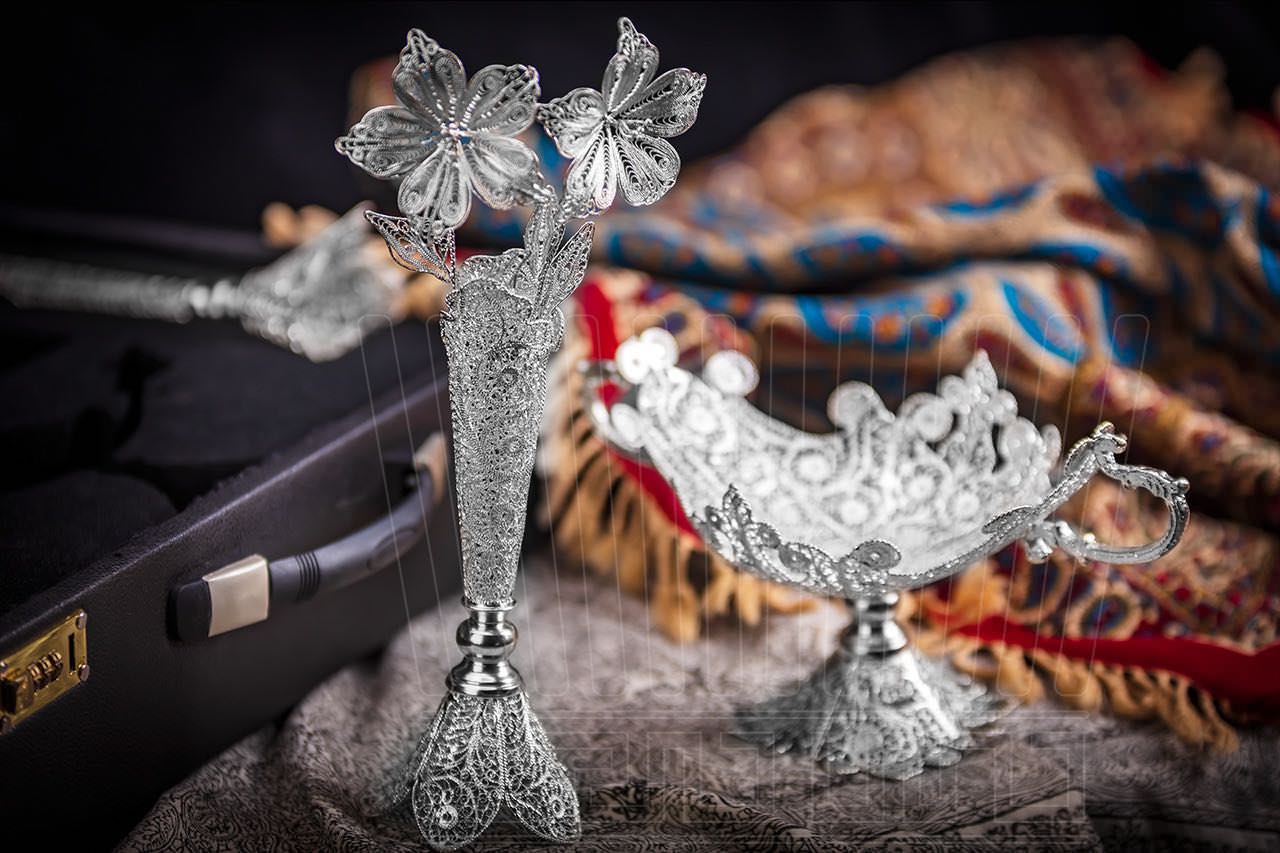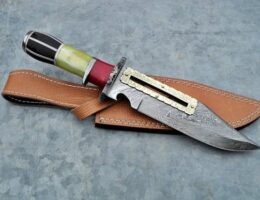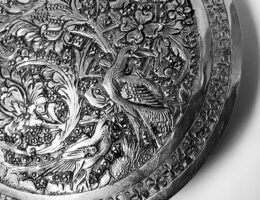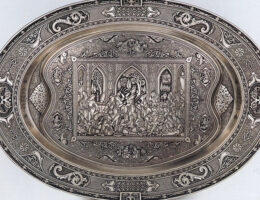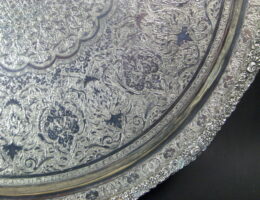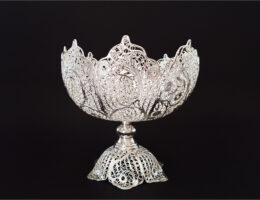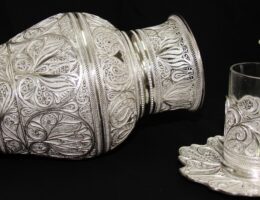IRAN ART EXHIBITION: ALL ABOUT FILIGREE ART IS HERE
Filigree History
Filigree is a branch of metal art that is made of thin silver and copper wire.
The today Filigree art is a product of working with silver and copper, which comes in the form of narrow products and this art has been linked with the use of traditional graphics and Arabesque designs by spending extraordinary time, expediency and skill of filigree artistry.
The silver bullion is hammered with a hammer or blooming mill machine in the form of four-edge and narrow wire, and first make small figures, then they are put together in a mold and soldered with lower-grade silver.
According to archaeological discoveries, according to most scholars, the oldest objects that can be searched include Filigree in Iran, belonging to the Achaemenid period from 033 to 055 BC. In the Sassanid era, expensive dishes, full of vertu and craftsmen of metalworkers, especially silver workers, were built for the benefit of the well-off society. In some cases, the use of gemstones has doubled the beauty of these objects.
The works of “Durallurpus ” show that the fabrication of Filigree has been remarkable in Iran during the period from 423 to 033 BC. Also, in the works discovered from Shush, Hamedan and Oxus Treasure, the antiquity of this art can be found.
Professor Arthur Apham Pupp in the book “Introducing Persian architecture”, referring to goldsmith and Silverwork in the years following the advent of Islam and then refers to some Filigree from the “Rey” region that belongs to the 21st Century.
Filigree is one of the crafts of Isfahan and Zanjan. In this city, silver items such as trays, Sugar Pot, the handle of cups, Brooch and … are made by using Filigree. There is no comprehensive information about Zanjan’s Filigree History; but in two ways, one can see the value of this worthy art:
First with the writing and travel logs of tourists who travel to this area and said about the fine art of Filigree in this area;
The second is using very few Filigree works that have existed and often belonged to the last two centuries. Since Filigree is also one of the branches of metalworking, it can be searched for its motion in the metalwork history of the region.
Art of Filigree
Before the Pahlavi era, in the first millennium of the Hijri, as a handicraft in Zanjan, it was only usual in this city, and during the reign of Reza Khan, some of the city’s artists moved to Tehran and Isfahan, also in other parts of the country, therefore, it was also popular in other parts of the country. Tea and juice set, jewellery boxes and knife handles are the most important part of Zanjani artists’ art in the following years, which gradually ornaments were added to these kinds of beautiful things. The boom of this craft began from the Seljuk era and peaked in the Safavid period. During the Seljuk period, most of the metalworkers were Khorasani artists living in the east and northeast of Iran, some of whom were left home in bloody and local wars, in other cities including Zanjan, Borujerd, Hamedan, Tabriz and especially Mosul city. Crafts including Filigree enjoyed a great boom in the Qajar era. Some Hookah tip, cup or trays handle in a different size, earrings and etc. remain from the Qajar period and after that, and some of which are kept in domestic and foreign museums and other parts in private collections or in families.
Filigree
The art of Filigree is a very fine decorative art that can’t be attributed to Iran and the ages of the past. Filigree is done in Europe and Asia. This art is also one of the branches of the art of working with metal and is considered to be the handicraft of Zanjan. Metals such as gold and silver and sometimes copper are used in Filigree.
People who are familiar with Iranian craftsmanship know well that Filigree is a noble handicraft in Zanjan.
According to the physical observations and the books, its history dates back to the BC during the Achaemenid and Sasanian times. But since the raw material of this industry is gold and silver and it is one of the most expensive metals, unfortunately, there are not many leftovers because they are looted in wars or melt for their value and their uses have been changing.
But according to the writings of great orientalists such as Arthur Apham Pope and Frederick Richard, they have pointed to the fine art of working with precious metals in Zanjan. Filigree is only popular in Zanjan until the Pahlavi era but after that, it was built in Isfahan, Tehran and Khorasan, and it is still ongoing. And some mistakenly think of it as Isfahan handicrafts.
IRAN ART EXHIBITION: Filigree has also been observed in Spain and Bulgaria.
Filigree steps
First of all, filigree thin wire should be prepared which is done according to the following steps:
Melt the silver bullion
Moulding and shaping in 5 mm strips
Heat the strips
Hammering the strips to form them in the form of four-sided bars
Heating the strips and passing it from the rolling machine to produce narrow wires
Braid the two wires to each other and pass through the special path of the rolling machine
The withdrawal of wires with a diameter of less than half a millimetre is Filigree.
After filigree wires are produced, it is time to design and shape them, which includes the following steps:
Waxing the metal surface that is usually rectangular and it is made of iron.
Prepare the mould of the desired shape and stick it onto the wax
Wrap the silver ribbon (slightly wider than the Filigree) around the mould to get the shape of the mould
Picking up the next walls with the help of a thin produced Filigrees.
Close the filigree with each other with the help of thin iron wires
Soldering wires to hold the filigree together
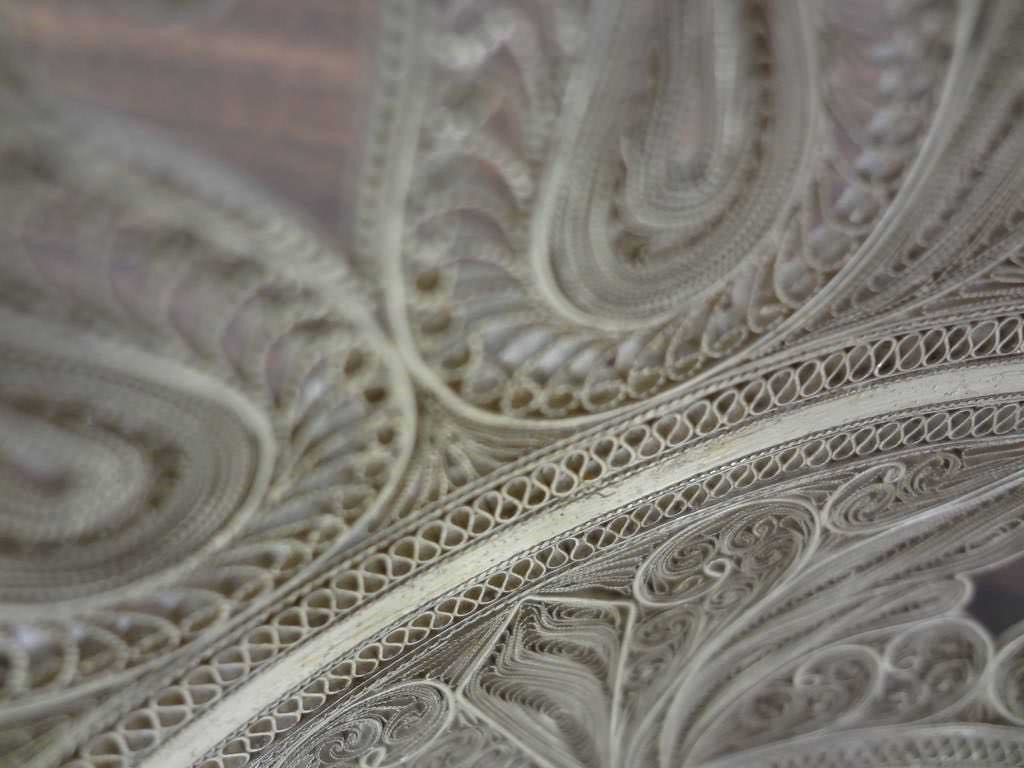
Filigree making method
This art is owed to artists who, with a very basic tool, have created valuable works and sometimes lost their sights on this path. Other consumables required in Filigree include natural wax, aquilegia, white alum, and sulphuric acid. The Filigree tool is similar to goldsmith tools.
To produce and make Filigree works, you must first have a filigree ribbon made of gold and silver, which is obtained by passing the silver and copper wire or bar from the rolling machine.
Once the Filigree tape is ready, it’s time to make a Filigree. At this stage, first, select a rectangular metal sheet whose material is opposite to the wire with a wide range of dimensions and sizes, and cover its surface with wax. So that a wax layer with thickness of 3 to 4 mm covers the screen, then the mould that is cut into the shape of the product is placed on the copper plate; afterwards, the strip is wider than the Filigree tape, and pass it around the mould to take the mould form and placed inside the wax.
Then, they split the overall layout by the later walls, and fill the median surfaces with the Filigree patterns previously made by the hand and the delicate instrument with a Filigree tape and at the last stage, they are knotted by very delicate steel wires so that the shapes are not falling apart. And then, by melting the wax, the madden filigree skeleton is separated from the bottom plate. The skeleton is placed on a flat surface and is soldered with a mixture of borax and silver filings and the gas flame moves on it.
IRAN ART EXHIBITION: As a result, the solder filling melts and causing it causes connect small figures together as well as the wall formed.
After that, firing is done and all parts are connected to each other by soldered filing.
After that, the firing was done and all the pieces of steel wires are cut and separated, the product, which is almost finished, is put in a launder containing a dilute sulfuric acid solution or boiled in a container containing “Raghab” (White and blue alum ), they boil until the additions and spots of silver are removed, and at the end, with the help of a delicate wire brush, the Filigree is erased and its possible roughness is eliminated by subtle rasp and sandpaper and connected with solder filing.
The other type of Filigree is a product made by bending and soldering Filigree, and the production method is such that first, they provide, the desired size of pages from Filigree and then with their help products such as cup and glass handler, sugar pot, Rose sprinkler, picture frames, white flowers, teaspoons and so on. And make up their handle and base with a lower-grade silver and attached them to objects. The common picture in Filigree is mostly subjective and inspired by old and traditional drawings of Iran.
